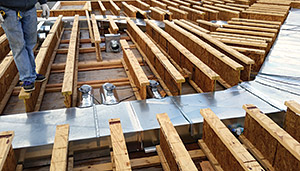
|
| Res-Com Heating and Air Conditioning, Elmsford, New York, works on a rooftop-zoning install in the Hamptons. |
For many seasoned HVAC contractors, the initial sales pitch when selling zoning to consumers can be as simple as a quick question-and-answer session.
The contractor asks, “When you enter your home at night and turn on a light switch, do all the lights in your house come on?” The customer, naturally, says, ‘No.’ So, the contractor continues, “Why not?” The customer replies ‘I don’t need all of the lights on because it wouldn’t be efficient.’
This is when the contractor drops the hammer on the conversation, “Absolutely. So, why do we ask our heating and air conditioning system to work in this manner? One switch [the thermostat] turns on, and you pay to heat or cool all the rooms in your house rather than only paying to heat and cool the rooms you are actually occupying.”
Now, obviously, this parenthetical conversation has slight changes from contractor to contractor (this version coming courtesy of Michael Goater, cofounder, Success4Others LLC, a Scottsdale, Arizona-based HVAC sales training firm), but the general principle remains the same: Zoning increases living comfort and energy efficiency.
This example was popular among contractors, but it’s just one way to start the zoning conversation. Dave Bettis, territory manager, Temperature Systems Inc., Green Bay, Wisconsin, said a technician starts the conversation by asking which room is the most uncomfortable. “This will get the consumer thinking and talking so you can solve the homes issues they bring to the table.”
The unfortunate reality for zoning, however, remains that, for now, it’s still a relatively niche aspect of the HVAC industry as zoning is installed on less than 3 percent of HVAC systems.
Learning and Selling the Product
So, how do contractors unfamiliar with zoning attempt to break into the market and sell zoning to consumers who may be similarly unaware or uninformed of its benefits?
“[Selling] zoning is very easy in new construction,” said David Richardson, manager, Weather Master HVAC, Knightdale, North Carolina. “When you explain to the builder/homeowner the benefits of having a thermostat in the master [bedroom] and one for the rest of the house, it sells itself. Communicating with customers and presenting them with all of the latest technology helps promote the best practices. I believe that educating your customers on the front end and explaining what zoning will do for them will be your best approach to selling zoning. You have to sell the concept before you sell the product. You need to make the homeowner ask you how much more for better comfort and control. Don’t lead with the pricing. When explained properly, the homeowner will want the better system design and improved comfort.”
Hank Bloom, owner, Environmental Conditioning Systems, Mentor, Ohio, emphasized one of the largest consumer complaints centers on a lack of comfort. Zoning largely solves that issue. “Zoning allows you to move air around to the zones that need it and back off on others,” he said.
As an assortment of contractors described the zoning process, a pattern began to emerge. Most of them have certain words or phrases they try to avoid when making a pitch to homeowners.
“When I provide seminars to contractors, I encourage them to never utilize the word ‘zoning’ during the sales process,” said Thomas Perry, technical services manager, Daikin North America LLC. “I prefer to ask the customer during the process how many thermostats they would like with their new system and show them the best possible locations for the thermostats. When discussing zoning, I prefer to use real-life examples and ask questions like, ‘How many temperature zones can be controlled in your vehicle?’”
The Difficulties of Zoning
Zoning’s comfort and efficiency are a great boost to consumers, but it does not come without its difficulties and struggless.
“In retail retrofits, it seems to be harder [to sell zoning] because they’ve had their systems in their homes without zoning and the extra costs tend to be a harder sell,” said Richardson. “With that said, we’ve been able to sell zoning for retrofits, and you should be able to, as well, as long as your salesmen can pitch all of the benefits and features and really make the homeowner realize you can give them more comfort than they had before.”
John Proctor, CEO, Proctor Engineering Group Ltd., largely agreed with Richardson’s comments, stating conventional ducted zoning certainly offers comfort.
“However, it has to be done right,” said Proctor. “No bypass ducts; otherwise, the homeowner is losing efficiency to accomplish the zoning task. Good systems can be designed and installed without bypass ducts. Not to mention that mini and multi splits can provide zoning that works.”
The bypass duct itself has been a great topic for debate throughout the country, most notably in California, where recent legislation covered in The NEWS has brought about a discussion on the effectiveness and impact of bypass dampers.
“The bypass issue is out there,” said Tom Jackson, CEO, Jackson Systems. “Large manufacturers can eliminate the bypass by eliminating static pressure. A dialogue is really at the forefront now. People are trying to figure out ways to simplify the bypass. That is a huge deal because we spend a lot of time on how to make retrofit zoning easier. Contractors are looking for wireless zoning solutions, and zoning, for us, is all about comfort. At the backend, there could be a little inefficiency. States like California acknowledge zoning can make homes more efficient.”
Regardless of how the bypass damper issue resolves itself in California, and to a lesser extent across the country, properly selling zoning continues to be an intriguing part of the job for many HVAC contractors.
Publication date: 5/18/2015
Want more HVAC industry news and information? Join The NEWS on Facebook, Twitter, and LinkedIn today!



Report Abusive Comment